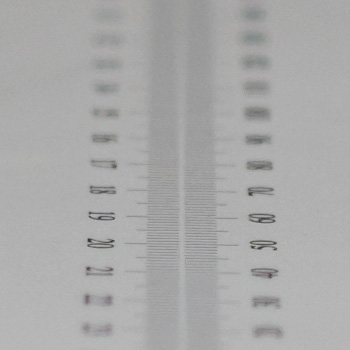|
Zeiss Touit 32mm f/1.8 (Fujifilm) - Review / Test Report - Analysis |
|
Lens Reviews -
Fujifilm X
|
|
Page 2 of 2

Distortion
It may be a bit of a shocker but despite the high price level, the Zeiss lens relies on image auto-correction when it comes to distortions. In untouched RAW files it shows a barrel distortion of 2% which is not dramatic but certainly visible in some scenes (technically at least). Oddly, at least CaptureOne produces a 1% pincushion distortion with activated auto-correction. This may vary across different RAW converters.
If you move your mouse cursor over the image you can switch to the corresponding "raw" results.
Vignetting
The auto-correction is also active for vignetting. JPEG images show a rather moderate light falloff of 0.8EV (f-stops) at f/1.8. As usual the vignetting decreases when stopping down and it's not really relevant anymore beyond f/2.8.
Uncorrected RAWs show a very different story with a very high falloff of more than 1.6EV at max aperture and still 1EV at f/2.2. The problem is mostly gone from f/4 onward.

MTF (resolution)
The Zeiss Touit 32mm f/1.8 delivered impressive results in the MTF lab. The image center is very good at f/1.8 and excellent from f/2.2 all the way up to f/8. The image borders/corners are good to very good straight from f/1.8 but they don't really benefit from stopping down anymore. Diffraction has a higher impact from f/11 onward although the setting remains easily usable.
The centering quality of the 2nd tested sample was good, much less so on the first sample. The field curvature is quite low.
Please note that the results were obtained from uncorrected RAWs. The quality of the (distortion-)corrected images depends on the specific converter so we decided to avoid this discussion here.
Please note that the MTF results are not directly comparable across the different systems!
Below is a simplified summary of the formal findings. The chart shows line widths
per picture height (LW/PH) which can be taken as a measure for sharpness.
If you want to know more about the MTF50 figures you may check out the corresponding
Imatest Explanations

Chromatic Aberrations (CAs)
At around 0.6px lateral CAs (color shadows at hard contrast transitions) are low and usually nothing to worry about.

Bokeh
A very important aspect of an ultra-large aperture lens is the quality of the bokeh (rendering of the out-of-focus blur). The Touit can produce convincing results here.
The foreground blur is very smooth and buttery. The more important background blur is just slightly more nervous but still very good.
 Out-of-focus highlights are evenly rendered with just a slight outlining effect. The highlight discs are circular in the image center but the shape deteriorates the more you watch towards the image borders. Stopping down improves these cat’s eyes towards a circle. The circular shape remains intact till about f/2.8. You can start to spot traces of an edgy aperture shape at f/4.
Out-of-focus highlights are evenly rendered with just a slight outlining effect. The highlight discs are circular in the image center but the shape deteriorates the more you watch towards the image borders. Stopping down improves these cat’s eyes towards a circle. The circular shape remains intact till about f/2.8. You can start to spot traces of an edgy aperture shape at f/4.

Bokeh Fringing / Longitudinal Chromatic Aberrations (LoCA)
Bokeh fringing is a common issue with fast glass. It's visible as halos of different colors in out-of-focus areas - magenta (red + blue) in front of the focus point and green beyond.
The Touit 32mm f/1.8 shows somewhat noticeable bokeh fringing at large aperture settings which can of be reduced by stopping down. The effect is gone from f/2.8 onward. Overall this aspect is better corrected than average.
|
Move the mouse cursor over the f-stop marks below to observe the respective LoCAs
|
| f/1.8 |
f/2.2 |
f/2.8 |
f/4 |
|

|
VerdictThe Zeiss Touit 32mm f/1.8 is capable of delivering the high quality results that we associate with this brand. The images are sharp straight from the max. aperture and the center quality is even stunning when stopping down. The peak quality of the borders/corners is certainly good but it stays somewhat short of the high expectations here. Lateral CAs may be just visible without being disturbing. Distortions and vignetting are usually auto-corrected either by the camera or your favorite RAW converter. However, when looking behind the scenes, you can spot higher than expected issues here - which is a bit disappointing for a pricey Zeiss lens. Given its max. aperture of f/1.8, the Touit is obviously meant for speed so it's good to see that the bokeh is of high quality and well controlled bokeh fringing.
Overall we liked the build quality - and looks - of the Zeiss lens. The incorporated materials are obviously of high quality. However, the aperture ring may not be everybody's darling - while it provides distinctive "clicks" you tend to change the setting by (un-)mounting because it turns too easily. To be fair this is hardly a showstopper though. We weren't totally convinced by the AF - e.g. Panasonic or Sony lenses feels quite a bit snappier here - but it does an Okay job in terms of AF speed and the generated noise level is quite low.
The question of the day is, of course, how it compares against its rival - the Fujinon XF 35mm f/1.4 R. The Zeiss Touit 32mm f/1.8 is generally a slightly better lens - especially at large apertures. However, from a real life perspective there is not too much in it and the Fujinon is both faster and also cheaper thus winning the value category.
Mechanical Quality:
★★★★★
Click here for an explanation of our star ratings
|